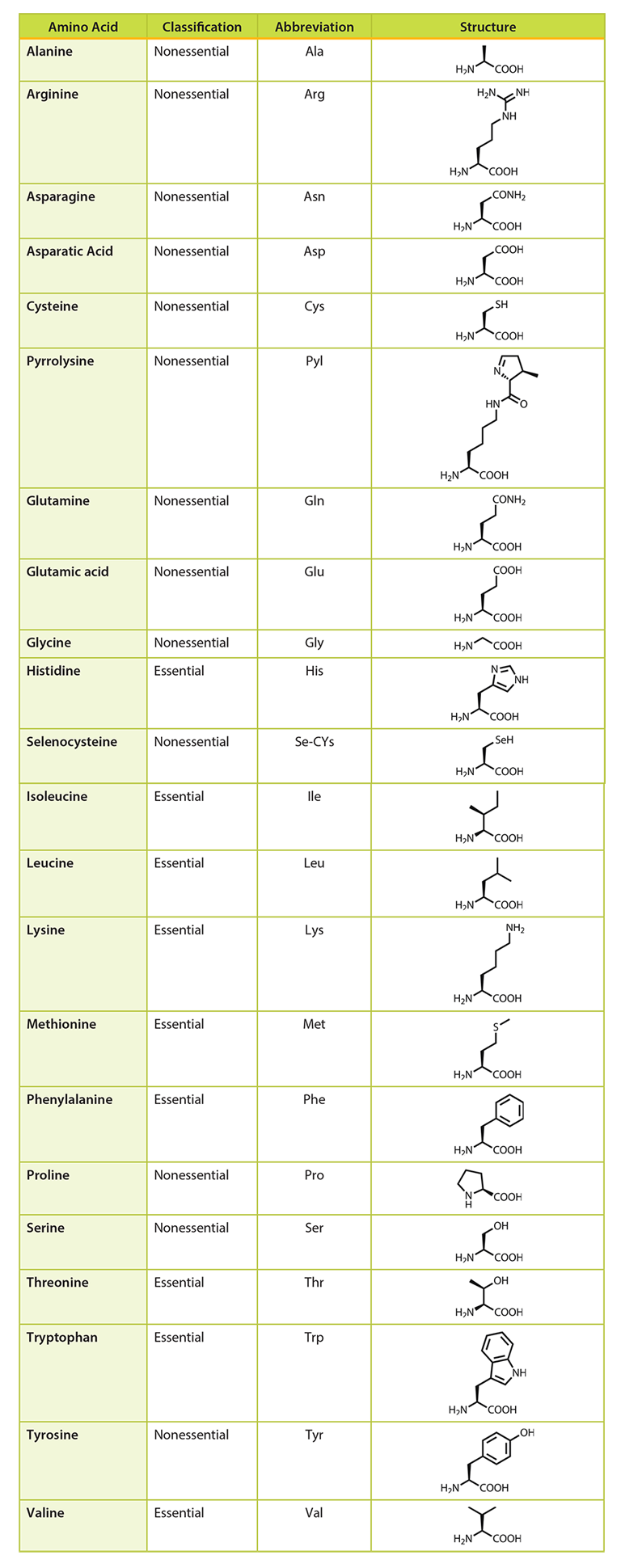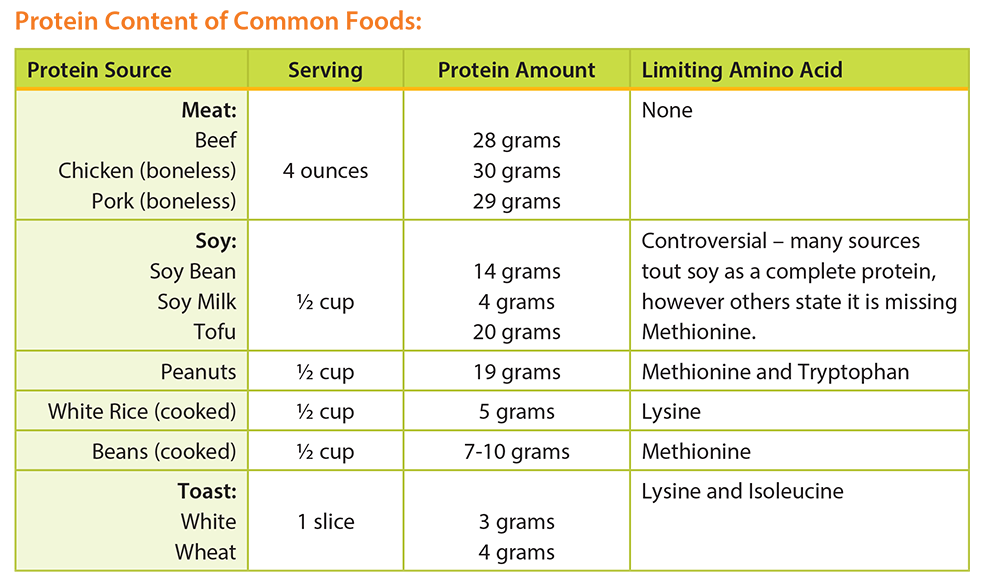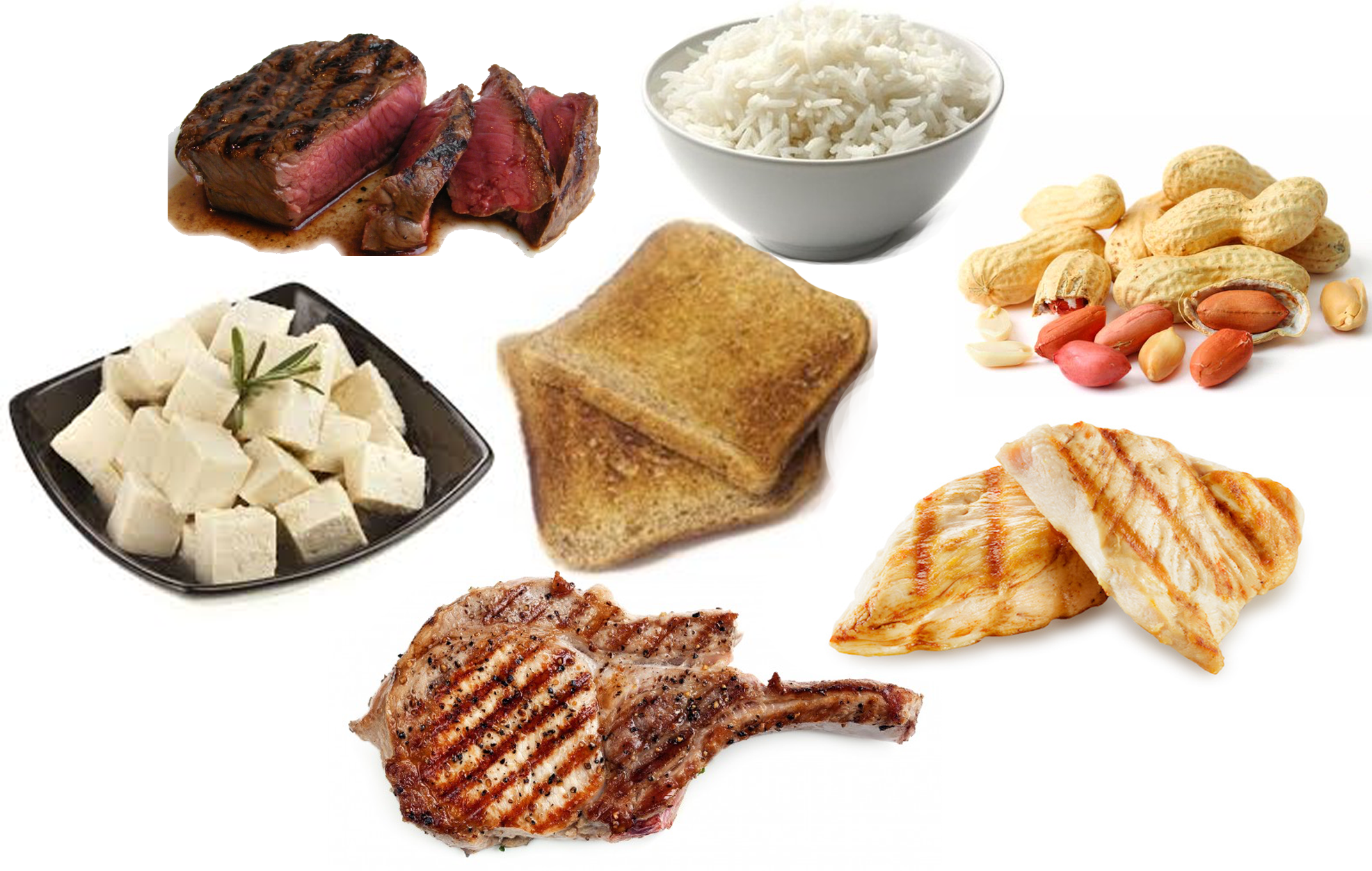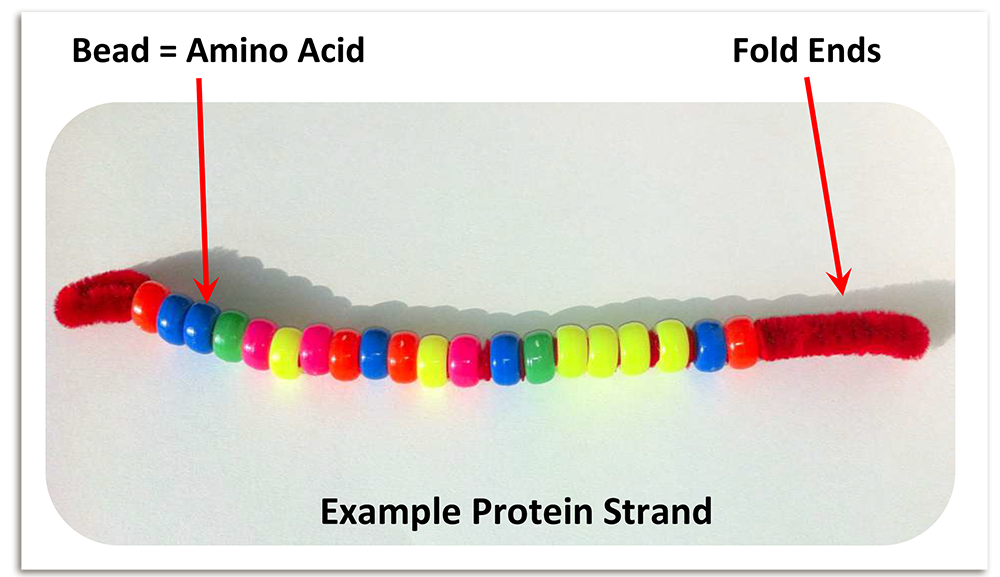Agricultural Literacy Curriculum Matrix
Lesson Plan
FoodMASTER Middle: Protein
Grade Level
Purpose
Students will examine dietary sources of protein and generally understand the relationship between protein synthesis and amino acids while completing an activity to use beads as a representation of amino acids to construct proteins (polypeptide chains). Students will identify complete and/or incomplete proteins found in both animal and plant food sources. Grades 6-8
Estimated Time
Materials Needed
Student Lab Materials, per group of 4-5 students:
- Protein Connection student handout, 1 per student (Key)
- The Building Blocks lab sheet, 1 per student (Key)
- Amino Acid Color Chart
- 4 Craft pipe cleaners
- 1 sandwich bag labeled “meat” containing 44 beads total (2 of each color of the 22 colors, no clear)
- 1 sandwich bag labeled “rice and beans” containing 44 beads total (2 of each color, no clear)
- 1 sandwich bag labeled “peanut” containing 44 beads total (2 of each color except for those assigned to Methionine and Tryptophan, and 4 clear beads)
- 1 sandwich bag labeled “toast” containing 44 beads total (2 of each color except for those assigned to Lysine and Isoleucine, and 4 clear beads)
Investigating Your Health Activity
- Healthy Proteins student handout, 1 per student
Vocabulary
amino acid: biochemical units from which all proteins are made; twenty different amino acids occur most commonly in the proteins of all life forms
complementary proteins: two or more proteins that work together to provide adequate amounts of the essential amino acids
limiting amino acids: an amino acid that cannot be synthesized in the body and can limit protein synthesis when deficient
protein: an essential nutrient responsible for building tissue, cells, and muscle
synthesis: the chemical production of a substance by changing or combining similar substances
Did You Know?
- Complete proteins (whole proteins) are proteins that contain all nine of the essential amino acids.1
- Protein is found in foods from both plant and animal sources.1
- Unlike fat and starch, the human body does not store excess amino acids for later use. Therefore they must be consumed in our food each day.1
Background Agricultural Connections
FoodMASTER (Food, Math and Science Teaching Enhancement Resource) is a compilation of programs aimed at using food as a tool to teach mathematics and science. For more information see the Background & Introduction to FoodMASTER. This lesson is one in a series of lessons designed for middle school.
| Weights & Measures | Fruits | Milk | Sugar | Protein |
| Food Safety | Vegetables | Cheese | Fats & Oils | Eggs |
| Energy Balance | Grains | Yogurt |
Proteins are created through a process called protein synthesis. Protein synthesis occurs inside of a cell. Transcription and translation are the two steps that occur during protein synthesis. Transcription is the first step in the process, where DNA is copied to create a RNA molecule. DNA and RNA are the two types of nucleic acids found in our cells. Translation is the second step in protein synthesis. During this step, RNA is translated into an amino acid sequence. During translation, elongation occurs. This step adds amino acids through the formation of peptide bonds. Amino acids are continually added until a complete protein is created.

Protein can be found in both plant and animal foods. Beans, nuts, grains, and seeds are all plant sources of protein. Animal sources of protein include meat, poultry, fish, eggs, and dairy. Animal foods contain all nine essential amino acids our bodies needs. Essential amino acids cannot be made by our bodies and must be consumed in our diet. They are also considered limiting amino acids because we need all of them for protein synthesis to function at maximum capacity. Without adequate amounts of each of these amino acids, our bodies cannot synthesize enough protein to maintain our muscle mass, bones, blood, and organs. For example, if we do not consume tryptophan, which is found in corn and animal foods, protein synthesis will be limited. Unlike animal sources, plant sources of protein can only provide us with some of the essential amino acids. These foods are called incomplete proteins. We must consume two or more of certain incomplete proteins to make complementary proteins. When consumed together, complementary proteins provide our bodies with the essential amino acids we would get from complete proteins. We have to be careful because only the right combinations will provide the necessary amino acids. For example, we would need to combine legumes with grains, nuts, or seeds to make complementary proteins.

Engage
- Display the following picture collage. Ask students to observe the foods and identify a common nutrient that all 7 foods contain. Allow students time to think and offer their answers. If needed, give the clue that this nutrient is found abundantly in some foods minimally in others. (protein)
- Ask students:
- What is protein?
- What foods provide protein in our diets?
- What are the building blocks of protein?

Explore and Explain
 Teacher Preparation:
Teacher Preparation:
- Review information found in the Background Agricultural Connections section of the lesson, lesson Procedures, and the attached Essential Files.
- Assign one bead or bead combination to each amino acid. Students will need to be given the key prior to beginning their lab. You may choose to provide each student group with a visual key using the Amino Acid Color Chart. The chart lists each amino acid name and abbreviation. Place corresponding beads on each amino acid.
- For each group, prepare four plastic bags containing a mixture series of “amino acids” for building each protein. Each bag should be labeled “Meat”, “Peanut”, “White Rice and Beans”, or “Toast” and contain 2 of each different colored “amino acids” (40 beads total) with the below exceptions:
- Meat Amino Acids: No missing amino acid
- Peanut Amino Acids: Missing Methionine and Tryptophan (replace both with clear beads)
- Toast Amino Acids: Missing Lysine and Isoleucine (replace both with clear beads)
- White Rice and Beans Amino Acids: No missing amino acid
- NOTE: See student Materials list: 8 beads will be left over representing the limiting amino acids from toast and peanuts
- Timesaver: Assign bead colors to each amino acid ahead of time. Consider using the supplemental Amino Acid Color Chart as a template by attaching (e.g. gluing) the beads directly to the chart. Provide one chart to each student group. Direct each group member to construct one protein molecule or assign students a strand to construct for homework.
- TIP: If materials are not available, use the amino acid color chart (no colors) for the symbols. Copy the amino acid color chart as is for meat, and rice and beans. For peanuts, white-out the abbreviations Met and Trp and copy. For toast, white out Lys and Ile and copy. Students can then cut out the amino acid symbols and place them in the correct order. The amino acid symbols may be glued to another sheet of paper if desired.
Lab Procedures:
- Distribute lab materials. It is recommended that materials are organized into stations for easier distribution. Students should be arranged in small groups of 4-5. Each group should receive the lab supplies outlined in the Materials section as well as 1 copy of The Building Blocks lab sheet and the Protein Connection handout.
- Ask students to read Protein Connection and complete the focus questions for this lab investigation.
- Launch the lab by asking students to predict which foods are considered complete proteins.
- Timesaver: Instruct students to work individually within their groups. Each student can construct one of the four proteins to speed up the process.
- Allow students to construct their protein models. Show students The Building Blocks lab demonstration video to show an example of how to construct a protein model.
- Students should find two of the food sources (bag of beads) are missing one or two amino acids (colored bead).
- Remind students to use a clear bead to represent any missing amino acid.
- Meat: Animals proteins are complete.
- Peanuts: Plant-based proteins are not complete, unless paired with another plant-based food that contains the missing amino acid. Legumes are missing the amino acids methionine and tryptophan.
- Toast: Plant-based proteins are not complete. Grain sources are typically missing isoleucine and lysine. Lysine is particularly low in grain sources that have been exposed heated, such as toast.
- White Rice and Beans: Plant-based proteins are not complete. Beans are typically missing methionine and tryptophan. On the other hand, grain sources are missing isoleucine and lysine. When the two are eaten together, the amino acids within each food combine to create a complete amino acid profile.
- Allow students to work in small groups on The Building Blocks lab sheet to further explore the topic and respond to lab questions.
- Consider allowing students to keep their protein strand. Students can wear the strand around their wrist like a bracelet and discuss what they learned about protein and sources of proteins with others.

Investigating Your Health Activity:
- Instruct students to research various sources of lean protein prior to beginning the investigation.
- Using the provided student background or information learned from researching protein sources, students should examine the food labels for three types of ground meat (i.e. 73% ground beef, 93% lean ground beef, and 93% lean ground turkey).
- Students can find food labels in the grocery store, on USDA’s FoodData Central, or use the labels provided below.
- If you choose to use the provided protein food labels, see the Teacher Key attached in the Essential Files portion of the lesson for answers to the Investigating Your Health lab questions. Answers to questions based on other food labels will vary.
- If completed in-class, allow students to work in small groups on the handout to further explore the topic and respond to questions.
- Follow-up with a class discussion about student findings related to the health benefits of consuming lean sources of protein.

Elaborate
-
Expand your knowledge about pork as a source of protein. Use the Pork: Sustainable and Healthy Protein educator packet for activities relating to environmental sustainability and the influence of traditions and culture on the food we eat. You can also explore pork recipes, learn about cuts of pork, and dig deeper into pork nutrition.
-
Build a model of an amino acid showing each molecule (C, O, H and N) and how they are bonded together (single vs. double). You can use play-doh and toothpicks or straws to make amino acid models. Select a different color play-doh for each atom (C, O, H, and N). Connect each of them based on amino acid structure using one or two toothpicks/straws depending on the type of bond (single or double).
-
Explore protein structures using the protein strands created with beads and pipe cleaners.

Evaluate
After conducting these activities, review and summarize the following key concepts:
- Protein is an essential nutrient in our diet.
- Meat provides a dense source of protein to our diets. Other plant-based foods such as soy-based products, nuts, and beans also contain protein, but typically in smaller quantities.
Sources
- http://www.sciencekids.co.nz/sciencefacts/food/proteins.html
Acknowledgements
This lesson was partnered with East Carolina University. The FoodMASTER program was supported by the Science Education Partnership Award (SEPA) which is funded from the National Center for Research Resources, a component of the National Institutes of Health.
- Primary Authors:
- Virginia Stage, PhD, RDN, LDN
- Mary White
- Ashley Roseno, MAEd, MS, RDN, LDN
- Melani W. Duffrin, PhD, RDN, LDN
- Graphic Design: Cara Cairns Design, LLC
Recommended Companion Resources
Author
Organization
| We welcome your feedback! If you have a question about this lesson or would like to report a broken link, please send us an email. If you have used this lesson and are willing to share your experience, we will provide you with a coupon code for 10% off your next purchase at AgClassroomStore. |
